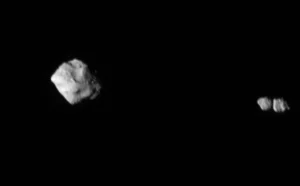
Last episode, we brought you some early science results from the Lucy mission, which is out exploring asteroids in the main belt on the way to hanging out amongst Jupiter’s Trojan asteroids. The biggest piece of news was the discovery that Lucy’s first target, a smallish asteroid called Dinkinesh, had a moon.
Well, hold onto your hats, that’s not the only wild thing about this encounter. It turns out that Dinky’s moon, lovingly referred to as Dinkymoon, is actually a contact binary. Or, as many astronomers are calling it on social media, a moonmoon. The other half of that contact binary was hidden due to the angle at which Lucy imaged the pair. Once the spacecraft – and the asteroids themselves – moved a bit, the other lobe of the moonmoon came into view.
Scientists who have been studying Dinkinesh are excited by this discovery for several reasons. One, contact binaries may be common, but we haven’t managed to see many of them up close. Two, we’ve never seen a contact binary orbiting an asteroid. And three, this orbiting moonmoon explains why researchers have been puzzled by odd variations in the brightness of Dinkinesh.
Lucy’s principal investigator, Hal Levinson, notes: “I would have never expected a system that looks like this. In particular, I don’t understand why the two components of the satellite have similar sizes. This is going to be fun for the scientific community to figure out.”
Right there with you, Hal. We’re definitely looking forward to the answers on this tiny system.
For now, Lucy will continue its journey to Jupiter’s Trojans by making another pass at Earth for a gravity assist in December and then a look at another main belt asteroid – Donaldjohanson – in 2025.
